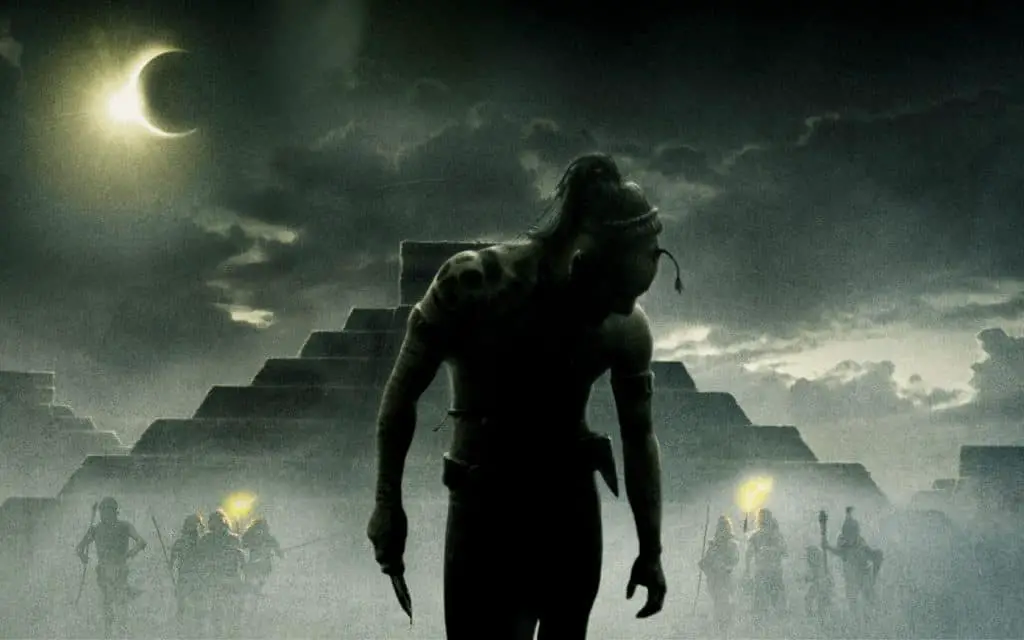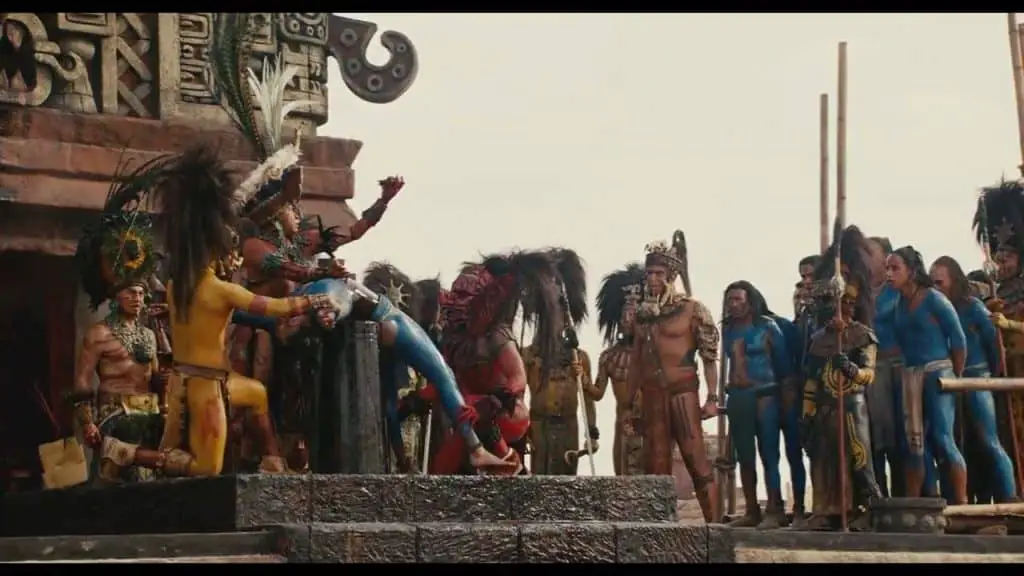Although “Apocalypto” has all the components of a classic action movie: a dynamic plot, a life-and-death struggle, an unsinkable protagonist and an indispensable happy ending, Gibson’s film can rightfully be called a large-scale philosophical story about the fate of people and civilizations.
The concept of “civilization” is not in the plural by accident: although the director made great efforts to reproduce the world of the long-lost Mayan civilization on the screen, the main ideas of “Apocalypse” are directly related to the world in which Gibson himself and most of his viewers live.

What is the movie about?
Gibson and the other filmmakers made no secret of the ideas they wanted to convey to the viewer. The Mayan civilization just thoughtlessly consumed all kinds of resources, like modern Western civilization, it destroyed everything around it (remember the terrible field littered with the swollen corpses of victims, through which the Jaguar Paw fled to escape) and was just as sure of its own invincibility. One of the authors of the script, F. Safinia, bluntly stated that the problems faced by the Maya are unusually similar to the problems facing our civilization today. And therefore, the analysis of the causes of the death of the Mayan civilization is also an attempt to find ways out of the impasse into which the cult of consumption leads the world.
But the illustration of how a great civilization destroys itself from the inside, Gibson’s film is not limited to. No less important for the creators of “Apocalypse” is another storyline related to the fate of one person. The Jaguar Paw is both an Indian from a forest tribe who lived in the early 16th century and an archetypal image that everyone understands. Turning to such basic concepts for our consciousness as life and death, escape and salvation, family and children, Gibson is trying to create a universal recipe for survival, suitable for any era.

According to the film, this recipe has three components: the absence of fear, the presence of a goal and martial art (in the broadest sense of the word). As Stone Sky said: “Fear is a disease,” and a sick person is not a fighter, he is weakened. And although the conquest of the ancient civilizations of Mesoamerica by the conquistadors remains behind the scenes, a hint of historical events is obvious: several thousand Spaniards conquered millions of Indians also because the latter were mortally afraid of pale-faced aliens and their unseen animals – horses. However, the question of whether “Apocalypse” can be considered a historical film in the full sense of the word remains debatable.
“Apocalypse” and historical facts
It is known that Gibson prepared very thoroughly for the filming: he visited the ruins of the Mayan cities, read their sacred texts, invited the famous historian, an expert on this civilization, Richard D. Hansen as a consultant. Striving for maximum reliability, the director even used the Yucatec language for filming, but all this did not save him from reproaches for distorting historical facts.

The main criticism concerns the discrepancy between the level of development of the Mayan civilization in the film and at the beginning of the 16th century. Yes, during its heyday, this civilization invented its own calendar, built magnificent temples and made large-scale human sacrifices to appease the gods. But the heyday ended by the end of the 9th century, i.e. the Mayan civilization fell into decay about half a millennium before the arrival of the conquistadors, so the Spaniards saw abandoned cities and a dying culture.
The film was criticized not only by historians, but also by the Mayan leaders living in the Mexican state of Yucatan, who said that their ancestors looked different, and that human sacrifices were made on major holidays and in moderation. However, it must be admitted that, deviating from historical plausibility in the details, Gibson managed to create an impressive image of the pagan civilization of the pre-Columbian era, with all its inherent features. And it’s not just about the sacrifices: the film portrays all classes of Maya society, from slaves and builders to warriors, priests and rulers.

What is the main artistic technique of the film?
The scale and depth of the film owes much to the parallelism technique actively used by the director. So, if members of a forest tribe hunt tapir in order to survive, then Mayan warriors hunt people to sacrifice them. Forest hunters open the carcass of a killed animal, taking out the heart, and in the same way the priests will open the bodies of sacred victims. In both opposing groups – the forest tribe and the Mayan warriors – there is a father-son pair, and so on.

Why does the film focus so much on the Jaguar Paw tribe?
The first 40 minutes of the film show the viewer all aspects of the life of a small Indian tribe: hunting, leisure, family relations. At the same time, the Indians are shown not as a set of faceless characters that represent the background for the main character, but as vivid individuals. Seven, the wife of the protagonist, is the embodiment of maternal and conjugal love; Stone Sky is a warrior and a sage with a great sense of his own dignity; the armless elder is the bearer of collective memory and mythological traditions. But the director’s task is by no means to idealize the victims, his goals are much more serious.

The Jaguar Paw Tribe is an archaic, almost prehistoric community, devoid of class divisions and living in complete harmony with nature. Its main value is children, and the conflicts between members of the tribe are of a humorous nature: these people have nothing to be seriously hostile for. The images of positive “savages” living in harmony and love, undoubtedly, go back to the philosophy of the Enlightenment, which contrasted the “children of nature” with the townspeople spoiled by civilization. In Apocalypse, the Jaguar Paw tribe in the jungle confronts the urban Mayan civilization as one of the possible alternatives.
What is the meaning of the prophetic dream of the Jaguar Paw and the prophecy of the girl?
Before the attack on the tribe, Lapa Jaguar sees a prophetic dream in which a wounded refugee from a neighboring tribe invites him to flee. Later, the girl, whom the Mayan warriors did not want to help, predicts their death. Both the dream and the prophecy are coming true. The introduction of these elements is intended to remind that we see all the events of the film not through the eyes of the director – our contemporary, but through the eyes of a 16th century Indian with his mythological consciousness.

Why does the warrior call Jaguar Paw “Almost”?
The meaning of the nickname given to the protagonist becomes clear if we remember that he almost managed to kill his opponent and almost managed to leave. Every time the Paw of the Jaguar is on the verge of death, he is almost doomed – but his presence of mind, warrior experience and good luck help to ward off inevitable death.

What’s the point of the final scene?
Some critics compared the ships of the conquistadors with the ancient “god from the machine”, ie. a clever trick to help cut through all the plot nodes in one fell swoop, but such a comparison is unconvincing. Nothing prevented Gibson and Safinia from “presenting” their tenacious hero with a complete victory over their pursuers, of whom there were only two left by the final. In fact, the appearance of Europeans, shaded by the sign of the cross, marks another alternative to the pagan Mayan civilization – Christianity. The Maya have no choice: either back, into the jungle, or forward, through a bloody transformation into a new world with new values: the time of their civilization is over. This interpretation fully coincides with the meaning put by the director in the title of the film.

What is the meaning of the title of the film?
The Greek verb “apocalypto” has a number of meanings in English, from which Gibson chose to “show a new beginning.” In his opinion, there is hope in the title of the film: when the history of one civilization ends, the history of another begins. True, in the process of creating this new civilization, the Europeans destroyed the Mayans in the same way as they destroyed the forest Indians – but this is already a topic for another film.







